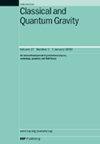Clock synchronization and light-travel-time estimation for space-based gravitational-wave detectors
IF 3.6
3区 物理与天体物理
Q2 ASTRONOMY & ASTROPHYSICS
引用次数: 0
Abstract
Space-based gravitational-wave detectors, such as the Laser Interferometer Space Antenna (LISA), record interferometric measurements on widely separated satellites. Their clocks are not synced actively. Instead, clock synchronization is performed in on-ground data processing. It relies on measurements of the so-called pseudoranges, which entangle the interspacecraft light travel times (LTTs) with the clock desynchronizations between emitting and receiving spacecraft. For interspacecraft clock synchronization, we need to isolate the differential clock desynchronizations, i.e. disentangle the pseudoranges. This further yields estimates for the interspacecraft LTTs, which are required as delays for the laser frequency noise suppression via time-delay interferometry (TDI). Previous studies on pseudorange disentanglement apply various simplifications in the pseudorange modeling and the data simulation. In contrast, this article derives an accurate pseudorange model in the barycentric celestial reference system, complemented by realistic state-of-the-art LISA data simulations. Concerning pseudorange disentanglement, this leads to an a priori under-determined system. We demonstrate how on-ground orbit determinations, as well as onboard transmission and on-ground reception time tags of the telemetry data, can be used to resolve this degeneracy. We introduce an algorithm for pseudorange disentanglement based on a nonstandard Kalman filter specially designed for clock synchronization in systems where pseudorange measurements are conducted in different time frames. This algorithm achieves interspacecraft clock synchronization and LTT estimation with submeter accuracy, thus fulfilling the requirements of TDI.天基引力波探测器的时钟同步与光行时估计
天基引力波探测器,如激光干涉仪空间天线(LISA),在相隔很远的卫星上记录干涉测量。他们的时钟没有主动同步。相反,时钟同步在地面数据处理中执行。它依赖于所谓的伪间隔的测量,它将发射和接收航天器之间的时钟不同步与航天器间的光传播时间(ltt)纠缠在一起。对于航天器间时钟同步,我们需要隔离差分时钟不同步,即解绕伪距。这进一步得出了航天器间ltt的估计,这是通过延迟干涉(TDI)抑制激光频率噪声所需的延迟。以往关于伪距解纠缠的研究在伪距建模和数据仿真方面进行了各种简化。相比之下,本文在质心天体参考系中推导了一个精确的伪距模型,并辅以最先进的LISA数据模拟。关于伪橙解纠缠,这导致一个先验的欠定系统。我们演示了如何使用地面轨道确定以及遥测数据的机载传输和地面接收时间标签来解决这种简并性。我们介绍了一种基于非标准卡尔曼滤波器的伪距解纠缠算法,该算法是专门为在不同时间框架内进行伪距测量的系统的时钟同步而设计的。该算法实现了星间时钟同步和亚米精度的LTT估计,满足了TDI的要求。
本文章由计算机程序翻译,如有差异,请以英文原文为准。
求助全文
约1分钟内获得全文
求助全文
来源期刊

Classical and Quantum Gravity
物理-天文与天体物理
CiteScore
7.00
自引率
8.60%
发文量
301
审稿时长
2-4 weeks
期刊介绍:
Classical and Quantum Gravity is an established journal for physicists, mathematicians and cosmologists in the fields of gravitation and the theory of spacetime. The journal is now the acknowledged world leader in classical relativity and all areas of quantum gravity.
 求助内容:
求助内容: 应助结果提醒方式:
应助结果提醒方式:


